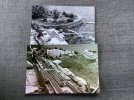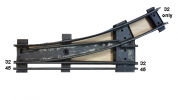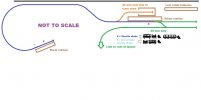Paul2727
Registered
Hi all,
I'm looking to make a long section of 3 rail dual gauge track 32 and 45 mm sharing one common rail.
Does anyone know if any manufacturer produce 32 mm track in Code 332 Rail? This would seem to make producing a gauge separator turnout much easier.
My other option would be to go the 4 rail route with the 32 mm track nestling inside the 45mm. Which one would be best?
And what are the pro's and con's of both types? Obviously the smaller the code of the 32 mm, the smaller the flanges would have to be on the stock.
Cheers,
Paul.
I'm looking to make a long section of 3 rail dual gauge track 32 and 45 mm sharing one common rail.
Does anyone know if any manufacturer produce 32 mm track in Code 332 Rail? This would seem to make producing a gauge separator turnout much easier.
My other option would be to go the 4 rail route with the 32 mm track nestling inside the 45mm. Which one would be best?
And what are the pro's and con's of both types? Obviously the smaller the code of the 32 mm, the smaller the flanges would have to be on the stock.
Cheers,
Paul.




